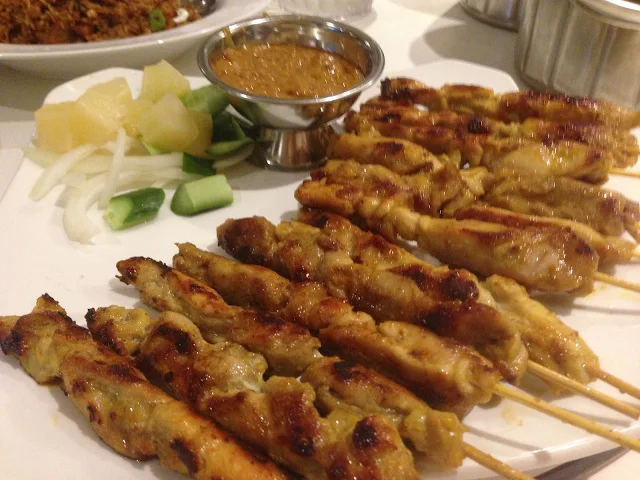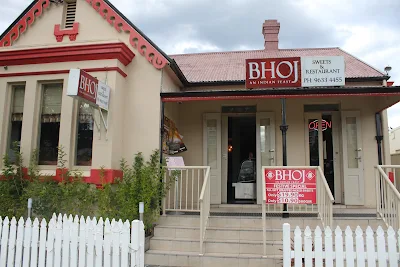You can recognise a well settled place when you walk through one. The vibes cascade in to your heart and gut feel. It is not just the multitude of colours, noise and people. It is as if you have to instinctively acknowledge the layer upon layer of culture, religion, happening and interaction. You are not a trained archaeologist, but you readily know there is trail of the preceding before the present. One such place is an inner city suburb in the Klang Valley in Peninsular Malaysia - Brickfields.
Even the English name belies that not all is what it seems to be. The colonial British named the suburb, but today they are no longer here or in charge. What strikes a first time visitor is the diversity of the main strip - Tun Sambanthan Road. The thoroughfare is named after an independence fighter for Malaya in the middle of the 20th century - TS came from an immigrant south Indian background.
The Golden Cheronese, or what the Peninsular was referred to at the height of the Greek golden age, was already playing out its strategic and inevitable role of being at the juncture of trade routes, adventurer conquerers and migrating peoples. In the context of the long history of mankind, South-east Asia was clearly more under the influence of significant Indian political, religious and cultural emphasis, until the advent of harnessing of the monsoon winds that propelled sailing ships from the Middle East and Europe. Hindu kingdoms with names like Sri Vijaya exerted power and homage upon the ordinary masses and remnants of the Indian sub-continental influence can be seen in Angkor Wat and Borobudur.
With this historical perspective, labour was recruited under the auspices of the British East India Company and then the British Empire (that never saw the sun set), to work on the then profitable rubber plantations scattered across the west coast of the Peninsular. The political stability, strong standards of governance and reliable economic structure proffered by the colonial Brits also attracted migrants from around Asia. These colonials loved to divide and rule, perhaps starting with their experience in Ireland, then spreading to Africa, India and the so called Far East. The need for a firm bureaucracy and political system to lord over the ethnics across the world required a mindset of effective business management and rule. A trend developed to develop geographical sectors according to racial background, for the colonials did observe the varying attitudes and behavioural characteristics of each ethnic group.
In Malaya, the hype was about the working attitude of the three main races in the 18th to 20th centuries. The Malays were seen fit to be administrators, the Chinese as profitable business people and the Indians as workers. I wonder why the British did not consider the Indigenous people of Malaya within this plan.
So the segmentation began, resulting in the layout of cities, rural areas and estates echoing this rather interesting mindset. Brickfields began to be a strong Indian community hub. Today it is promoted as the Little India of Kuala Lumpur ( "Muddy Confluence"), as tourism soared with the advent of greater mobility, air travel and rising incomes. Sited on the western side of the city centre, Brickfields has had vibrancy further enhanced with the contemporary development of adjoining Sentral, with its train platform convenience, shopping facilities, accommodation hub and airport access. This has a historical basis, for Brickfields long ago was the main depot built for the transportation network known as the Malayan Railway in the colonial period.
Against this background, I had a recent opportunity to check out this inner city delight buzzing with various aspects of Indian heritage, foodie offerings and traffic buzz. More often than not, I would stay in the suburbs outside the city centre when in the Klang Valley, especially with the network of shopping centres, coffee shops and friends. This time around, in five minutes, I could go for walks along TS Road, soak in with the flowered garlands and pancake rotis for breakfast. I enjoyed coming across individuals with a painted dot on their foreheads.
The senses experienced from my childhood, even if I did not grow up in Brickfields, came rushing back, for I had lovely and caring Indian neighbours when growing up in Penang - such is the hidden benefit of living in a harmonious multi-cultural society, when people still exchanged home cooked dishes, children were colour blind and there was more emphasis on sharing commonalities than bringing out differences. The cultural familiarity put me in a safe and comfy place in my heart, enhanced by the cooking aromas, the colours of clothes, the tilt and accent of languages spoken and the appetising lure of niche food. All at once, the layers were peeled from under Australian norms to reach back to feel another world which had been forgotten and buried in time.
So despite the advent of "divide and rule", the colonials under rated the power of the human instinct to enquire, interact and socialise. It all starts with simply food, that first item across the fence that builds up friendships. I was back to freshly made rotis with simple curry gravy, the quintessential breakfast amongst working colleagues in this country as well. I was so glad my Aussie mate was partaking this kind of food with me on this visit. The Tamil music, the scent of sandalwood joss sticks and the dazzling but still natural colour of blooms on garlands - TS Road revealed all these. The perfumery can be too strong on some passer-bys. The traffic can build up to a buzz. The script on sign boards contrasted with the Roman alphabet. No matter how the level of activity in Brickfields was carefree and random, it was at the same time purposeful.
One lazy afternoon on this recent visit, I had the opportunity of trying the lunch of long ago in my mind - getting steamed rice or Briyani, and then going round the table to pick your own servings of the various dishes that catch the attention of your eye and palate. Call it Nasi Kandar, name it Chap Fun or whatever. The selections are all cooked that morning by Big Mama, usually a petite lady with heaps of experience in southern Indian cuisine, surrounded by her sons. Every dish is a labour of love and passion that she puts in. The quality of curry gravy is often above average. So I could sample this and that, with memories of the aromas that drifted to my nostrils on walking back from school. I do not recall the humidity nor the bright sunlight. I only remember the spices, the appetising experience and those unassuming afternoons.
People I knew then were not laden with much money and yet the level of happiness was so much better than I see in so called rich suburbs around the world. Individuals and families did their best to rise above challenges. The country was relatively young, promising and with positive possibilities. So I watched with interest this current younger generation, walking along the road, with their own kind of hope in their eyes.
One evening, the nearby Maha ViharaTemple held their biggest event of the year - the street parade with various floats sponsored by different parties to mark Vesak Day, an occasion to remember the birth, Enlightenment and passing of the Buddha. This is Little India, but it is not just Hindu, for in a multi-cultural place like Malaysia, there is still the embracing of diversity like I recall from my childhood. Brickfields reminds me that it is still all there in the 21st century, even if some quarters have chipped away the extent of such racial tolerance. You can also get Halal food, not far from a single Chinese restaurant - and Western backpackers can still roam the streets with relative impunity.
Brickfields boasts of more than garment shops and ethnic cafes. There is the Temple of Fine Arts. The Sri Lankan community also congregate at the Sri Kandaswamy Temple at Scotts Road. The Malaysian Association of the Blind, the YMCA and the Global Indian International School have sizeable operations here. Churches include Our Lady of Fatima, the Zion Lutheran Church, the Holy Rosary Church and the Indian Orthodox Church. The Three Teachings Chinese Temple and a Surau complete the multi-cultural profile of Brickfields.
Societies which are open to the world, absorb the best from foreign influences and share inner core values will still do well in the future. History has demonstrated this observation, from the rise of trading city states to the cosmopolitan nature of capitals of great empires. At times there may be discouragement and setback, but the wisdom and leadership of key individuals do significantly count in the progress of mankind in this respect.
So what is the foreseeable future for the Indian community in the current Federation of Malaysia? Their compatriots from the Mother Country have been making huge strides in other nations - think of the Silicon Valley in California, the contributions of Indians in the United Kingdom and their long economic presence in South Africa. Indian families have seen their members transported to various corners of the globe like the Chinese - and whether they are in Canada, the Caribbean, Dubai, Thailand, Hong Kong or Australia, the journey and story of their Diaspora continues.
And I asked why the whole place is called Brickfields. Kuala Lumpur was a village built by the various racial groups, including the Kapitan Cinas of old. Kapitan Yap Ah Loy reserved land for the setting up of a brick making industry here after the British Resident of the State of Selangor - Sir Frank Sweetenham - ordered for buildings to be built of brick. Kapitan Yap Kwan Seng established the kilns. This is one glorious example of why historical names of places should not be forgotten, abandoned or changed - I am glad that this has not happened to Brickfields.


















































